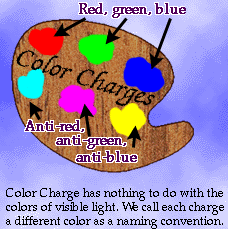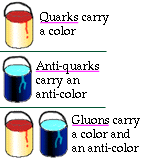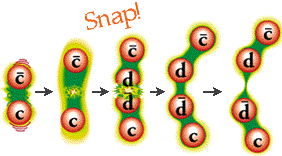Color and Confinement (original) (raw)
Quarks and gluons are color-charged particles. Just as electrically-charged particles interact by exchanging photons, color-charged particles exchange gluons in strong interactions. In so doing, these color-charged particles are often "glued" together.
 The main difference between strong and electromagnetic interactions is the fact that the strong force-carrier particles (the gluons) themselves carry color charge. Photons, on the other hand, have no color charge.
The main difference between strong and electromagnetic interactions is the fact that the strong force-carrier particles (the gluons) themselves carry color charge. Photons, on the other hand, have no color charge.
Two or more quarks close to each other rapidly exchange gluons, creating a very strong "color force field" binding the quarks together. There are three color charges, and three corresponding anti-color (complementary color) charges. Quarks constantly change their color charge as they exchange gluons with other quarks.

Each quark has one of the three color charges; and each antiquark has one of the three complementary color charges. Gluons carry color/anti-color pairs (they don't necessary have to be the same color; i.e.. red / anti-blue gluons are legal). While there are 9 possible combinations of color/anti-color pairs, due to symmetry considerations one of these combinations is eliminated. A gluon can effectively carry one of eight possible color/anti-color combinations.

Quark Confinement:
 Color-charged particles cannot be found individually. For this reason, the color-charge quarks are confined in groups (hadrons) with other quarks. These composites are color neutral.
Color-charged particles cannot be found individually. For this reason, the color-charge quarks are confined in groups (hadrons) with other quarks. These composites are color neutral.
Not until the development of the Standard Model's theory of the strong interactions could physicists explain why the quarks combine only into baryons (three quark objects), and mesons (quark-antiquark objects), but not, for example, four quark objects. Now we understand that only those combinations are color neutral. Particles such as ud or dd that cannot be combined into color-neutral states are never observed experimentally.
How does color charge work?
**Color charge is always conserved.**Therefore, when a quark emits or absorbs a gluon, that quark's color must change in order to conserve color charge. For example, suppose a "red" quark changes into a "blue" quark and emits a "red/anti-blue" gluon. The net color is still "red."

Quarks emit and absorb gluons very frequently within a hadron, so there is no way to observe the color of an individual quark. Within a hadron, though, the color of the two quarks exchanging a gluon will change in a way that keeps the bound system in a color-neutral state, so it will stay observable.
Color-Force Field:
 The quarks in a given hadron madly exchange gluons. For this reason, physicists talk about the color-force field which consists of the gluons holding the bunch of quarks together.
The quarks in a given hadron madly exchange gluons. For this reason, physicists talk about the color-force field which consists of the gluons holding the bunch of quarks together.
If one of the quarks in a given hadron is pulled away from its neighbors, the color-force field "stretches" between that quark and its neighbors. In so doing, more and more energy is added to the color-force field as the quarks are pulled apart. At some point, it is energetically cheaper for the color-force field to "snap" into two new quarks. In so doing, energy is conserved because the energy of the color-force field is converted into the mass of the new quarks, and the color-force field can "relax" back to an unstretched state.

Quarks cannot exist individually because they must maintain a color-force field with other quarks.